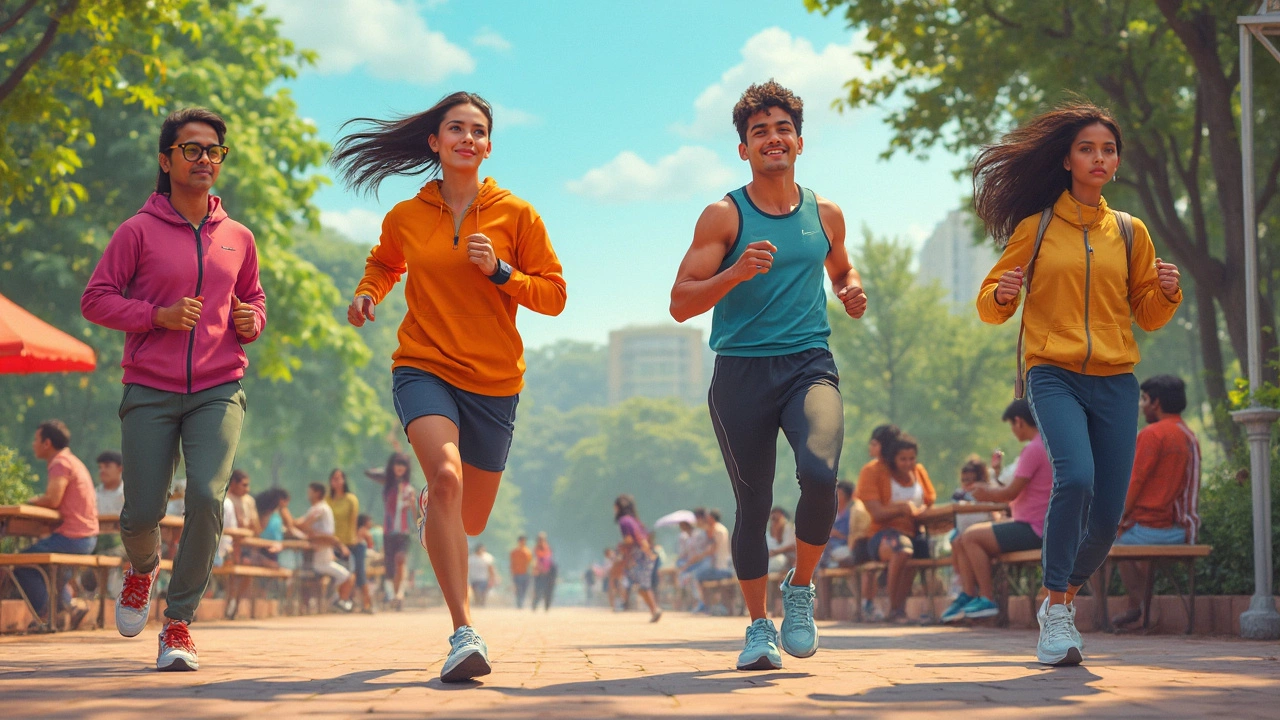If you’ve ever stood in a shoe shop baffled by a wall of trainers, you’re not alone. Picking the right pair can get confusing fast—especially when each style is built for a different purpose and feels totally different on your feet. Grab the wrong type and you’ll notice right away, even if it’s just during a walk to the park with your kid or a quick jog before work.
Here’s the trick: knowing what each of the four main types actually does for your feet and lifestyle. You wouldn’t use running trainers for lifting weights, or wear chunky fashion trainers on a hike. The pros get super picky about this stuff for a reason. Everyday folks like us? We should too—thanks to how much it affects comfort, injury risk, and even style.
Jasper learned this the hard way, trying out my old running shoes on the basketball court. He slipped, almost face-planted, and now won’t touch them unless he’s sprinting. The lesson? Trainers aren’t just trainers. Pick the right type, and suddenly your shoes work for you, not against you.
Running Trainers
Running trainers are built for hitting the pavement or trail, not for lounging around. Their main job is to protect your feet and joints while you pile up the miles. The big deal with these shoes is the way they absorb shock on each step and keep your foot stable. Most running trainers focus on three things: types of trainers for different runs, how much support you need, and how heavy or light they feel on your feet.
Ever notice the heel on most running trainers sticks out a bit? That’s intentional. Those chunky midsoles aren’t just for looks—they’re packed with foam to soak up impact. Some brands, like Nike and Adidas, add special tech like air or gel bubbles right under the heel. Lighter models ditch some of the foam so you can pick up the pace, which is perfect for speed work or racing.
People often make rookie mistakes when buying running trainers. Here’s what to keep in mind:
- Fit over looks: A good fit beats trendy colors. Wiggle your toes and make sure the heel doesn’t slip.
- Replace often: Running trainers usually last 300-500 miles before they lose their cushioning. After that, they just don’t protect you the same way.
- Match your needs: If you run on trails, go for trail running shoes with grippy treads. Road runners? Look for smoother soles and extra cushioning for pavement.
You might see some stats thrown around about running trainer choices. Check this out as a handy reference:
| Feature | Benefit | Common Range |
|---|---|---|
| Heel-to-toe drop | Helps decide foot strike (big for injury prevention) | 4-12mm |
| Shoe weight | Light is better for speed, heavier for cushioned comfort | 210-350g (men’s size 9) |
| Cushioning | Protects joints and absorbs shock | Minimal to max (depends on the model) |
Run in the wrong trainers just once, and you’ll feel it the next day—maybe in your knees, maybe in your hips. Go to a running shop and get your gait checked if you’re not sure what works for you. A solid pair makes all the difference in sticking with running, whether you’re prepping for a marathon or just chasing the dog around the block.
Cross Trainers
Let’s talk about cross trainers—the Swiss Army knife of the types of trainers world. These shoes are built to handle a bit of everything: gym workouts, short runs, group fitness classes, and even everyday errands. They strike a balance between cushioning, stability, and durability. That combo makes them an easy pick if you want just one pair of trainers to cover most bases.
What really sets cross trainers apart? Their sole and construction. The bottoms are usually wider and flatter compared to running shoes, giving you more grip and stability during side-to-side moves (think squats, lunges, or jumping jacks). You won’t feel like you’re teetering on stilts during weights or HIIT sessions. Plenty of brands add a reinforced toe and heel, so the shoes can stand up to changes in movement without falling apart after a few sessions.
Dr. Michael Fredericson of Stanford Sports Medicine puts it like this:
“Cross trainers perform best for people mixing activities—short runs, cardio classes, basic gym routines. But don’t swap them for sport-specific shoes if you want the best results for serious running or basketball.”
One quick tip: Don’t wear cross trainers for long-distance running. The padding isn’t placed the way true running trainers are, so you’ll feel it in your knees and shins if you push too far. But if your workout involves a bit of treadmill time, some burpees, and a round of deadlifts, cross trainers are right at home.
- Great for: Gym sessions, circuit training, fitness classes
- Avoid for: Trail runs, serious basketball, or extended road running
- Bonus: Lots of gyms will suggest cross trainers for newbies—it helps prevent newbie injuries.
| Feature | Cross Trainer |
|---|---|
| Sole Width | Wide and flat |
| Cushioning | Moderate – not too soft, not too hard |
| Arch Support | Medium (works for most feet) |
| Durability | High (especially on the sides and toe) |
The best brands? Nike Air Monarch, Reebok Nano, and New Balance MX series show up pretty often in gyms for good reason—they’re comfortable and they last. If you’re not sure what to grab and want one pair for almost everything, slide into some cross trainers and you’ll be set for 90% of the action.

Fashion Trainers
Fashion trainers have exploded in popularity over the last decade. If you walk down a city street or scroll Instagram, you'll see chunky soles, bright color pops, and big logos everywhere. These shoes put looks before sports performance—so don’t expect them to hold up in the gym. Instead, they’re made to pair with everyday outfits, from jeans to summer shorts to even casual suits if you’re bold enough.
There’s good reason why the top brands—think Nike, Adidas, New Balance, and Alexander McQueen—still fight for a spot in your closet. Sneaker sales in the fashion segment jumped by nearly 20% from 2022 to 2024, with limited drops and collaborations selling out in minutes. Some rare releases even double as investments; the 2020 Dior x Air Jordan 1, for example, resold above $10,000 at its peak.
| Top Features | Benefit |
|---|---|
| Bolder designs | Shows off your style and sets you apart |
| Premium materials | Looks great, but can be less breathable |
| Less support | Not made for running or workouts |
| Brand collaborations | Exclusive releases, hype factor |
Picking fashion trainers is all about personal style, but there are a couple of tips to keep your feet happy and your wallet in check:
- If you’re planning on walking a lot, check the insole and padding. Some can be surprisingly flat and tough on your feet after a full day.
- Stick to neutral colors like white, grey, or black for something you can wear with almost any outfit. But if you’re going bold, go all in—statement trainers get noticed.
- Watch out for fakes, especially if you’re chasing popular brands or resale pairs. Stick with trusted retailers or verified reseller sites.
- Remember: they’re not meant for sports. If you use fashion trainers as gym shoes, expect them to fall apart fast.
The bottom line? Fashion trainers combine comfort and looks for everyday life. They’re not one-size-fits-all, but they’ll definitely help you put your best foot forward where style matters. Among types of trainers, these are the ones that say the most about you—they’re as much a fashion choice as a shoe.
Lifestyle Trainers
These are the trainers you’ll reach for when comfort is your top priority but you don’t want to look like you just rolled out of the gym. Types of trainers isn’t just a technical thing—lifestyle trainers are proof that function and fashion really can live together. Some brands call them sneakers or casual shoes, but the idea is always the same: shoes you can wear day in and day out without sore feet or weird looks.
Lifestyle trainers are designed for daily, low-impact wear. You’ll see them paired with jeans, joggers, dresses—pretty much anything outside of work or serious sport. Materials are usually soft (like mesh, suede, and lightweight synthetics) and focus heavily on breathability and cushion. Soles are often made with EVA foam, so you’re not clopping around like you’re wearing bricks.
Here’s an eye-opener: in 2024, global lifestyle trainer sales actually made up about 53% of the whole trainer market. That’s more than all running, sport, and fashion trainers combined. No surprise—you spot them everywhere from airports to grocery stores, especially with trends shifting toward relaxed dress codes.
| Brand Example | Notable Feature | Target Wearer |
|---|---|---|
| Nike Air Force 1 | Classic design, padded sole | Teens & adults |
| Adidas Stan Smith | Sleek leather look, everyday comfort | All ages |
| New Balance 327 | Retro vibe, lightweight foam | Trend-focused crowd |
When shopping for lifestyle trainers, try these tips:
- Check the insole—removable means you can swap out for extra support if needed.
- Look for grip on the outsole; some are really slick and won’t handle wet sidewalks well.
- Stick to neutral colors for max versatility, unless you love standing out.
- If you’ll be on your feet all day, test them for flex. Some look comfy but turn out stiff.
Biggest thing to remember? You don’t have to spend a fortune—budget lifestyle trainers easily rival premium brands for everyday comfort. Once you’ve got the right pair, you’ll notice yourself skipping the same old shoes every morning, grabbing these instead almost by default. That’s how you know you nailed it.

